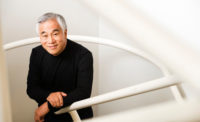|
Canada’s most influential architect, Arthur Erickson, died on May 20 at the age of 84.
Erickson is the only Canadian ever to be awarded the AIA’s Gold Medal (1986). He built to acclaim in Japan, Kuwait, England, and up and down the U.S. West Coast, from the San Diego Convention Centre (1981) to the Tacoma Museum of Glass (1996). His legacy, however, is most evident in the city of both his birth and death, Vancouver.
One has to go all the way back to Daniel Burnham’s shaping of Chicago to find another North American architect who so dominated a large city’s architectural culture. Like Burnham, Erickson was celebrated for the combination of his technically innovative and elegant buildings as well as his progressive urban ideals and schemes. Many regard Erickson as the intellectual author of “Vancouverism”—an approach to city building characterized by developments that are high-density, high-amenity, socially inclusive, and respectful of nature.
Arthur Erickson’s artistic talents, global outlook, and mass media skills were honed early. He had a gallery show of his paintings while still a teenager; studied Japanese; and spent World War II serving with the British Intelligence in India, followed by a stint running the national radio system of Malaya. Upon his return from Asia, a Fortune Magazine profile of Frank Lloyd Wright inspired an application to architecture school.
Upon graduating from McGill in 1950 he extended a Pilkington Glass traveling scholarship into a 30-month architectural tour around the Mediterranean and across Europe, and then returned to Canada. His earliest built works were increasingly ambitious houses in wood, then concrete—their designs inspired in equal parts by Richard Neutra, fellow Northwest Modernists, and his Mediterranean travels.


Two 1960s designs (with former partner Geoffrey Massey) in Brutalist concrete established his reputation: the mega-structural Simon Fraser University set on Burnaby Mountain, and the waffle-framed MacMillan-Bloedel office tower downtown. In the 1970s, he implemented his trademark ideas of new modes of public space, integration of nature into city centers, and buildings as landforms in his three block-long Robson Square. In 1976 came the completion of his masterwork: the Museum of Anthropology at the University of British Columbia. Erickson abstracted forms from indigenous dwellings for its cascading concrete portals, and the museum is often cited as a definitive example of Critical Regionalism in North America.
For much of his career Erickson was more admired than supported in Vancouver. He was the sole designer of no major design commissions there between the 1983 Vancouver Art Gallery and the 2002 Waterfall Building (designed in association with Nick Milkovich Architects). Unpaid Middle Eastern work and the strains of commuting weekly between his offices in Toronto, Vancouver, and Los Angeles led to a high-profile bankruptcy in 1992.
Carving out a role as public intellectual that few architects risk, he constantly called for better designs from his peers, and for Vancouver to make the investments in transportation, housing, and institutions befitting its inevitable fate as a world city. His pronouncements doubtlessly scared away clients and cost him financially, but their legacy has galvanized Vancouver, and provided a template for architects everywhere struggling to reconcile form-making, city-building, and living-with-nature.
Architecture critic Trevor Boddy is curator of "Vancouverism: Architecture Builds the City," a major exhibition that features key Erickson works. It will be presented at Woodwards' Atrium January 7 through March 21 during Vancouver's 2010 Winter Olympics. Afterward, it will move to the Shanghai World Expo, where it will be shown from May 1 through October 31, 2010.



